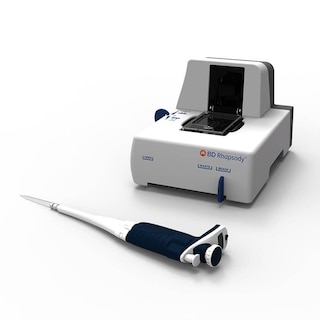-
Your selected country is
Middle East / Africa
- Change country/language
Old Browser
This page has been recently translated and is available in French now.
Looks like you're visiting us from {countryName}.
Would you like to stay on the current country site or be switched to your country?


Oligo Rat Anti-Mouse CD197 (CCR7)
Regulatory Status Legend
Any use of products other than the permitted use without the express written authorization of Becton, Dickinson and Company is strictly prohibited.
Preparation And Storage
Recommended Assay Procedures
Put all BD® AbSeq Reagents to be pooled into a Latch Rack for 500 µL Tubes (Thermo Fisher Scientific Cat. No. 4900). Arrange the tubes so that they can be easily uncapped and re-capped with an 8-Channel Screw Cap Tube Capper (Thermo Fisher Scientific Cat. No. 4105MAT) and the reagents aliquoted with a multi-channel pipette.
BD® AbSeq tubes should be centrifuged for ≥ 30 seconds at 400 × g to ensure removal of any content in the cap/tube threads prior to the first opening.
Product Notices
- This reagent has been pre-diluted for use at the recommended volume per test. Typical use is 2 µl for 1 × 10^6 cells in a 200-µl staining reaction.
- The production process underwent stringent testing and validation to assure that it generates a high-quality conjugate with consistent performance and specific binding activity. However, verification testing has not been performed on all conjugate lots.
- Please refer to bd.com/genomics-resources for technical protocols.
- Caution: Sodium azide yields highly toxic hydrazoic acid under acidic conditions. Dilute azide compounds in running water before discarding to avoid accumulation of potentially explosive deposits in plumbing.
- Source of all serum proteins is from USDA inspected abattoirs located in the United States.
- Illumina is a trademark of Illumina, Inc.
- Please refer to http://regdocs.bd.com to access safety data sheets (SDS).
- For U.S. patents that may apply, see bd.com/patents.
Companion Products






The monoclonal antibody 4B12/CCR7 reacts with the mouse C-C chemokine receptor type 7 (CCR7). CCR7 is also known as CD197 (previously known as EBI1, Ebi1h and CMKBR7) and plays a central role in mediating homeostatic B and T lymphocyte trafficking to and within secondary lymphoid tissues. CD197 is a seven-transmembrane, G-protein-coupled, 43 kDa glycoprotein receptor that is specific for the CC chemokines, MIP3ß/Exodus-3/ELC/CKb11/Scya19/CCL19 and 6Ckine/Exodus-2/SLC/TCA4/CKb9/Scya21/CCL21. The mouse Ccr7 gene is located on chromosome 11. CD197 (CCR7) is differentially expressed by subsets of thymocytes. Positive CD197 expression appears to be involved in the cortex-to-medulla migration of positively-selected thymocytes wherein they complete functional maturation including the establishment of central tolerance. It is most highly expressed by some mature medullary single-positive thymocytes. CD197 is also expressed by subsets of mature peripheral CD4+ and CD8+ T lymphocytes including naïve and regulatory T cells and central memory T cells. In addition, it is differentially expressed by subsets of B lymphocytes, dendritic cells, and Langerhans cells. CD197 serves as a homing receptor that helps guide these various cell types to and within lymphoid tissues. In this way, CCR7 supports protective immunity while safeguarding self tolerance. Reportedly, the 4B12/CCR7 antibody is not agonistic, is not blocked by CCL21 nor by physiologic levels of CCL19, nor does the antibody block the binding of CCL21 to CCR7. The immunogen used to generate the 4B12 hybridoma was a mouse CCR7-transfected rat cell line.
Development References (5)
-
Britschgi MR, Link A, Lissandrin TK, Luther SA. Dynamic modulation of CCR7 expression and function on naive T lymphocytes in vivo. J Immunol. 2008; 181(11):7681-7688. (Clone-specific: Flow cytometry). View Reference
-
Forster R, Davalos-Misslitz AC, Rot A. CCR7 and its ligands: balancing immunity and tolerance. Nat Rev Immunol. 2008; 8(5):362-371. (Biology). View Reference
-
Kurobe, H., Liu, et al. CCR7-dependent cortex-to-medulla migration of positively selected thymocytes is essential for establishing central tolerance. Immunity. 2006; 24(2):165-177. (Biology). View Reference
-
Ohl L, Mohaupt M, Czeloth N, et al. CCR7 governs skin dendritic cell migration under inflammatory and steady-state conditions. Immunity. 2004; 21(2):279-288. (Clone-specific: Flow cytometry, Immunofluorescence, Immunoprecipitation, Neutralization). View Reference
-
Schweickart VL, Raport CJ, Godiska R, et al. Cloning of human and mouse EBI1, a lymphoid-specific G-protein-coupled receptor encoded on human chromosome 17q12-q21.2. Genomics. 1994; 23(3):643-650. (Biology). View Reference
Please refer to Support Documents for Quality Certificates
Global - Refer to manufacturer's instructions for use and related User Manuals and Technical data sheets before using this products as described
Comparisons, where applicable, are made against older BD Technology, manual methods or are general performance claims. Comparisons are not made against non-BD technologies, unless otherwise noted.
For Research Use Only. Not for use in diagnostic or therapeutic procedures.
Report a Site Issue
This form is intended to help us improve our website experience. For other support, please visit our Contact Us page.